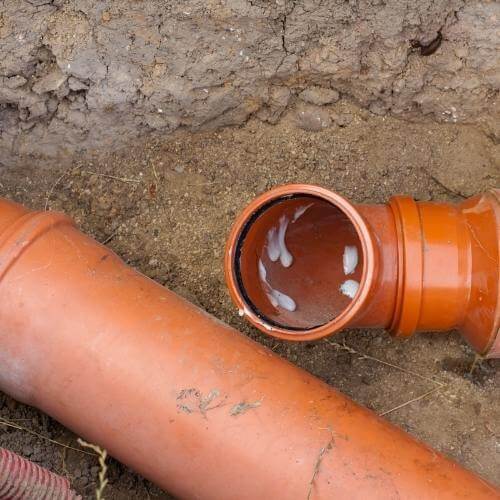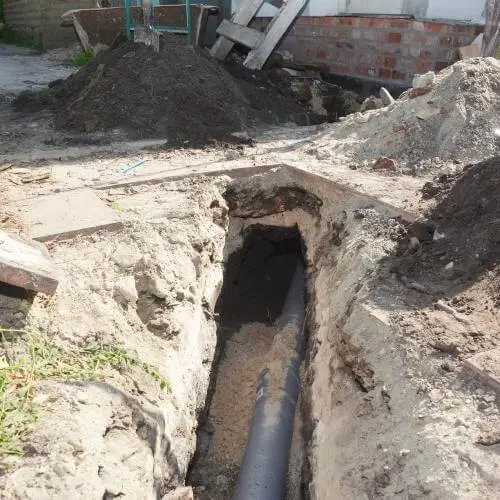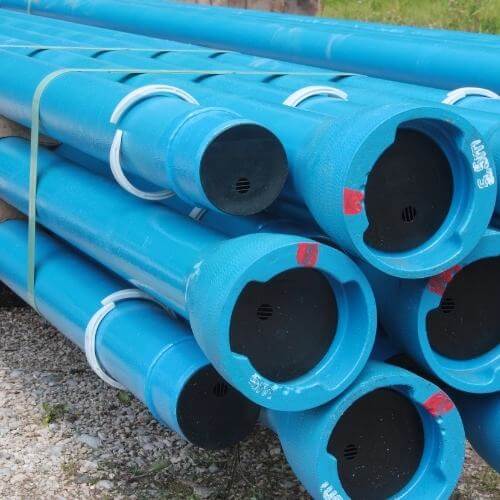Are you having problems with the part of the plumbing that is connecting to city sewer line? Then you might need to repair or replace the sewer line from house to street!
When you purchase an old house, you also buy old pipes – unless on occasions when the previous owner replaced the pipes with PVC ones. However, most homes that were built before the ‘80s have original pipes.
Pipes have a lifespan. They can last for a long time, but they are not eternal. This means that old homes have pipes that are nearing the end of their life.
But how can you know whether you need to replace the sewer line from house to street? And can you do this on your own?
If such questions interest you, you’re in the right place. Here you can learn everything about the sewer lines and what you can do to prevent water damage.
Let’s get started!
What Is the Pipes’ Lifespan?

Pipes made out of different materials have a different lifespan. For example, a cast iron sewer pipe can last up to 100 years in ideal conditions – but the conditions are rarely ideal. Your pipe will always be exposed to temperature changes, salts, or even tree roots that can damage the pipes underground!
In general, the lifespan of your sewer pipes is:
- Brass pipes: 40 – 70 years.
- Clay pipes : 50-60 years
- Copper pipes: 50 years.
- Galvanized steel: 20 – 50 years.
- Cast iron: 75 – 100 years.
- PVC pipes: 100 years to indefinitely.
Of course, this this only includes pipes that haven’t been physically or chemically damaged.
As you can see, these lifespans are fairly long, and chances are your house is younger than that. However, the problem lies in polybutylene.
Polybutylene is a type of plastic resin that was commonly used for water supply piping from the years 1978 to 1995. This material is affordable ad easy to install, which is why it was considered the piping material of the future. It’s especially common in the Northwest Pacific and Mid Atlantic states, but it was used nationwide.
Polybutylene pipes are grey or white in color and have a dull finish, compared to PVC pipes that are mostly shiny. Also, their water mains are mostly white, but they can come in black or grey, as well.
Unfortunately, the predictions for polybutylene have failed, as it turns the material is extremely susceptible to breakage and water damage. Because of this, professionals discontinued installing polybutylene pipes. However, you aren’t legally obliged to replace them, and many sewer lines in old houses still have this type of pipes.
Most of the time the reason behind replacing sewer line from house to street is polybutylene. However, this type of problem can occur with any other material.
When to Replace Sewer Line from House to Street?

In general, you don’t have to replace the pipes just because you suspect your sewer line is old. If there are no leaks and everything seems to work properly, there isn’t a reason to touch anything. However, replacing them before the damage is done might be a good idea, as you can avoid some water damage.
Some of the main signs that you might have the problem with this type of sewer line might include:
- Low water pressure.
- Sewage smell outside your house.
- No water inside your house.
- Dirt in water.
If you notice any of these problems and the cause isn’t located in the pipes inside your house, then the issue might be with the pipe that connects your piping to the main line in the street.
The only way you can truly know whether you need to replace sewer line from house to street is to call a professional plumber who will inspect the pipes. To do so, a plumber should conduct a CCTV sewer camera inspection. This way, they’ll be able to see how the pipe looks from the inside. [1]
If they notice any damage, a professional will offer a solution. However, a type of damage that occurs between your house and the street will usually have to end in replacing the sewer line.
How to Replace Sewer Line from House to Street?

The method of replacing your sewer line will depend on the damage. This is why it’s important to call a professional inspection first.
Fortunately, these repairs are usually non-invasive and fairly easy to fix. Most of the time, this can be fixed with pipe bursting – a minimally-invasive trenchless pipe repair method. This is the case, for example, if you have sewer line to street clogged with debris.
The problem arises in the case of your pipe collapsing or of it is back-pitched. If this is the case, you’ll need to dig a trench and to replace the sewer line via conventional methods.
This is something that a professional should do, but you can attempt to do it yourself if you feel like you have some tinkering skill. However, to do this, you’ll need to follow local sewer line laws and get a permit from your city. The city might want to conduct an inspection before the permit is granted. [2]
If you want to attempt to do this on your own and you’ve gotten the permit, the first thing you need to do is to check how deep your sewer line is. In colder states, they can be buried as deep as six feet, while in California they might be as shallow as 18 inches.
Also, this type of problem can be challenging to fix during winter, as the ground will be frozen.
When fixing the sewer line from house to street, you should follow the OSHA’s safety guidelines. You aren’t legally obliged to – but this is the general recommendation. This might include using trench shields or protective gears. [3]
Without further ado, here is the step-by-step guide to replacing your sewer line:
Step One
The first thing you need to do is to find the exact location of your sewer line. This can be done by conducting an inspection with a CCTV sewer camera, as these cameras usually have a radio transmitter that can help with location. Of course, you can always guess, but this can cost you money.
Once you’ve located the pipe, you need to find a way to mark its length. It’s very important to be accurate. Otherwise, you might be digging in the wrong spot, which is both cost and time-consuming.
Step Two
When you’ve located the sewer line, it’s time to find the utility lines. The easiest way to do this is to call the national call-before-you-dig phone number – 811. Once you do this, a professional will come to help you find the exact location of everything.
Keep in mind that they won’t be able to tell you the location of anything the homeowner has installed after the house has been build.
Step Three
Once everything has been located, it’s time to break any concrete obstructions that might be in your way. This might include:
- Driveways
- Sidewalks
- Patio
And other constructions.
You can do this with various electric tools available in large hardware stores, or you can use an 8-pound sledgehammer.
Step Four
Next, you have to dig a trench. Use whichever tool you find to work the best for your situation. Keep in mind that the trench can be anywhere between 1.5 to 6 feet deep.
Once you’ve reached the pipe, dig sideways. This will create some room for everything to be done properly, and it will help clear away the dirt and soil.
As the replacement process can last a while, the trench will need to be open for a while. You need to keep it covered all the time, to make sure no one falls into it.
Keep in mind that you might need a chainsaw to cut through tree roots. These might happen even if you don’t have a tree in your backyard. And no, Epsom salts will not help you in this situation.
Step Five
It’s time to cut or disconnect the pipe from both the main house line and from the city sewer line. The right location for this is usually at the property line cleanout and at the main cleanout.
From here on now, everything is rather straightforward. You should simply remove the old pipe, replace it with the new one, and reconnect it back to your system. The exact process will depend on the type of your pipe.
Step Six
Finally, turn the water on in your property and see if everything is working properly. If it is, this means the process has been completed the right way. In the case something is still wrong, it might be the time to call a professional to inspect everything and tell you where you went wrong.
If everything is working properly, it’s time to fill in the trench. This will be much easier than digging the trench – just make sure to keep the soil compact.
You might also have to repair all concrete constructions that had to be destroyed in the process, especially if they belonged to the city.
What Is the Cost to Replace Sewer Line from House to Street?

The exact cost of the sewer line replacement is challenging to predict upfront. This is because it depends on several factors, such as:
- The trench depth.
- Removal of the concrete constructions and their repair later on.
- The removal of existing pipes.
- The pipe size.
Either way, this isn’t a cheap process. You can expect the costs to be between $3,000 and $7,000. However, depending on your exact situation, it can be more expensive.
When Is the City Responsible for Sewer Lines?
Sometimes, the city might be responsible for replacing the sewer line from house to street. This is if the damage is found on the sewer lines that start at the main underground pipe. This is the line that carries wastewater and waste from your home to the local treatment plant or other designed location.
These lines usually sit beyond your property’s boundaries and belong to the city, which is why the responsibility for this type of repairs isn’t yours.
However, if the problems are located on the pipes that lead to the main line, you will be the one responsible for the repairs.
Does Insurance Cover the Costs?
Most homeowners have a standard home insurance policy that can be liable for many costs associated with your property. Unfortunately, the sewer line replacement isn’t included in this type of coverage. Even the flood insurance that you ca buy through the National Flood Insurance Program won’t cover repairs to the sewer lines. [4]
Fortunately, there are some providers that offer add-ons to the policy, and this might include water or sewer backup. You might even find a standalone policy for sewer repairs in some insurance companies.
Some of the insurance companies that offer standalone policies that might help you with the costs associated with replacing the sewer line from house to street include:
- The American Water Resources.
- The American Family’s service line coverage.
- Erie Insurance’s service line packages.
Not all plans will cover for all expenses, nor all steps of the repair process. However, if you plan on purchasing an old home, it might be smart to get yourself covered. Otherwise, you might end up with huge expenses in a rather short time.
No insurance will allow you to get a policy when the damage has already been done. You need to be smart about this and buy a policy in advance.
Bottom Line
Replacing a sewer line from house to street isn’t a challenging procedure, even though it will cost you lots of money and it will take a lot of time.
Fortunately, with just a bit of skill and some paperwork, you will be able to complete the process on your own.
Before you attempt to do anything, contact the local authorities or a local plumber to see where the damage is located. Chances are the city will be the one responsible for the repairs.

Michael Davis is a heating & plumbing expert who currently works as independent contractor in SC. He also writes for Plumbertip.
For almost 10 years he worked on various plumbing tasks across South Carolina.


